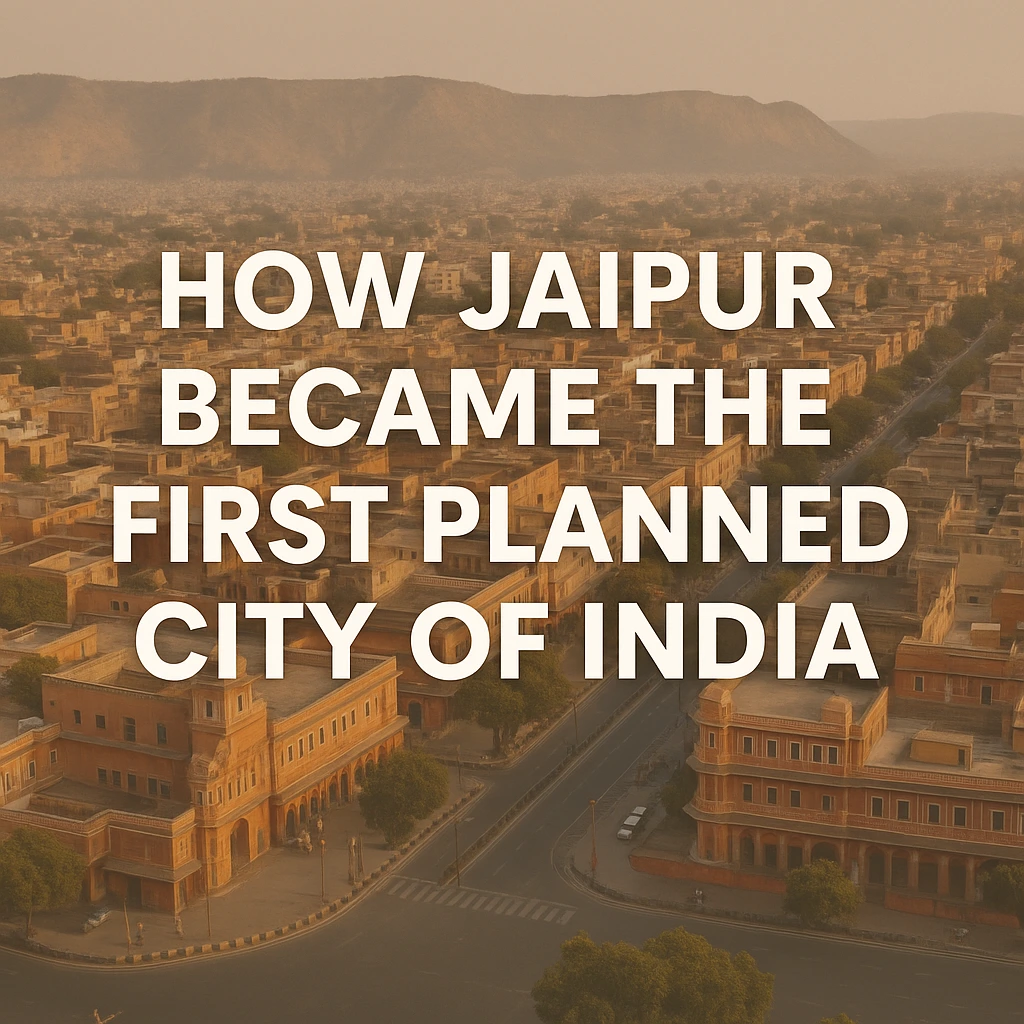
Hello I m Pitamber, your friendly tour guide in Jaipur. Today, I will tell you something special that most visitors don’t know. Jaipur is not only a famous tourist place, it is also the first planned city of India The idea behind Jaipur city architecture was to follow Vastu Shastra, which brings balance and harmony. That’s how Jaipur became the first planned city in India. Many people love Jaipur for its colours and culture but few know this hidden part of Jaipur history. Today, I will take you on a journey to understand how this wonderful planned city in India was born.
A Brief History of Jaipur
Located in the heart of Rajasthan, Jaipur is known worldwide as the Pink City. But beyond its beautiful palaces, forts, and colorful markets, Jaipur has a fascinating story that many people don’t know. Before Jaipur was built, the capital of the Kachwaha Rajput dynasty was Amber, a small town about 11 kilometers away.
Amber served as the royal seat for many years, but as time passed, the city started facing problems. It was surrounded by hills and had limited space to grow. Water was also becoming a major issue. The growing population and need for better infrastructure made it difficult for Amber to continue as the capital.
This is when the idea for a new, well-planned city was born — a city that would be larger, stronger, and smarter.
The Visionary Behind Jaipur: Maharaja Sawai Jai Singh II
The man behind the creation of Jaipur was Maharaja Sawai Jai Singh II, who ruled from 1699 to 1743. He was not only a brave ruler but also a scholar, astronomer, and city planner. He had deep knowledge of mathematics, science, and architecture.
Sawai Jai Singh II wanted to build a new capital that would be modern, scientific, and efficient, yet still rooted in Indian culture and tradition. He studied ancient Indian texts like Vastu Shastra and Shilpa Shastra and used them as the foundation for designing the new city.
His dream was to create a city that was safe for its people, easy to live in, and fit for royal life. That dream became Jaipur — the first planned city of India.
Read Our Latest Blog :- One day Jaipur Itinerary
Designing Jaipur: The Role of Architect Vidyadhar Bhattacharya
To turn his dream into reality, Jai Singh II appointed Vidyadhar Bhattacharya, a skilled architect from Bengal. Bhattacharya was an expert in Vastu Shastra and had deep knowledge of geometry and astronomy.
Using these principles, he designed Jaipur’s city layout in the form of a grid, based on Mandala design — a sacred symbol representing balance and order. The city was divided into nine blocks (called Chowkris), with two blocks for royal buildings and seven for the public.
The streets were wide and straight, crossing each other at right angles — something very modern for its time. It was one of the earliest examples of urban planning in India, showing how Jaipur was designed smartly, not grown randomly like other old cities.
Vastu Shastra and Astronomy in City Planning
One of the most unique things about Jaipur’s design was the use of Vastu Shastra and astronomy. The whole city was planned in alignment with cardinal directions (North, South, East, West), and the buildings were placed based on natural energy flow.
Jai Singh II also used his knowledge of the stars and built Jantar Mantar in Jaipur — a large astronomical observatory. This helped him pick the most auspicious time and location to lay the foundation of the city.
This combination of traditional science and modern thinking made Jaipur a masterpiece of Indian planning.
Strong Walls and Secure City Gates
In the 1700s, cities had to be protected from invaders. So Jaipur was not just planned for beauty, but also for safety and defense. The city was built with strong walls all around it and had seven main gates to enter and exit.
These gates — like Ajmeri Gate, Sanganeri Gate, and Chandpole Gate — were well-guarded and designed to control movement in and out of the city. The city’s layout also helped troops move quickly if there was a threat.
This made Jaipur not only a planned city, but also a protected city.
How Jaipur Became the Pink City
The world knows Jaipur as the Pink City, but do you know why? In 1876, Prince Albert of Britain was visiting India. To welcome him, Maharaja Ram Singh ordered the entire city to be painted pink — the color of hospitality. The pink color gave Jaipur a unique and charming look, and it was so loved that it became permanent.
Since then, Jaipur has proudly held the title of The Pink City.
Jaipur’s Markets and Public Spaces
Jaipur was designed not just for kings, but also for the common people. Its markets were carefully planned within the city grid. Popular bazaars like Johari Bazaar, Tripolia Bazaar, and Bapu Bazaar were placed in locations that made shopping easy and organized.
Unlike other cities with narrow, messy lanes, Jaipur’s markets were wide, clean, and aligned, showing great planning. The city also had open public spaces, gardens, and community centers where people could gather, celebrate, and relax.
Water Supply and Smart Infrastructure
Even in the 18th century, water was a big concern — especially in Rajasthan’s dry climate. But Jaipur’s planners thought ahead.
They built stepwells, water tanks, canals, and drainage systems to collect and manage water. This helped the city stay self-sufficient, even during dry seasons. This kind of sustainable city design was far ahead of its time and shows just how smart Jaipur’s planning really was.
Jaipur’s Unique Architecture
The architecture of Jaipur is a mix of Rajput, Mughal, and some European styles. Buildings were made with local pink sandstone, and they followed a uniform design, which gave the city a harmonious and elegant look.
Famous buildings like the City Palace, Hawa Mahal, and Jantar Mantar are perfect examples of how beautiful and precise the city’s design was. They show both the artistic beauty and scientific knowledge that went into creating India’s first planned city.
A Model for Future Indian Cities
Jaipur’s planned design inspired many other cities in India. While cities like Delhi and Mumbai grew without any real planning, Jaipur stood out as a smart, structured city. It became a model for urban planners who wanted to blend tradition with modern city needs.Even today, experts in city development and architecture study Jaipur to learn from its balanced design.
Jaipur as a UNESCO World Heritage City
In 2019, Jaipur was officially added to the list of UNESCO World Heritage Cities. This global recognition was not just for its beautiful buildings and rich culture, but also for its unique city planning.
UNESCO praised Jaipur for how it used ancient Indian knowledge, scientific thinking, and urban design to build a city that still works beautifully today.
Jaipur Today: Growth and Preservation
Like many growing cities, modern-day Jaipur faces challenges — population growth, traffic, pollution, and pressure on old buildings. But efforts are being made to preserve the original layout, restore historic sites, and improve modern infrastructure.
The goal is to protect Jaipur’s legacy while keeping it strong for the future.
Conclusion:
Jaipur is not just a tourist spot or a royal city — it is a vision brought to life by Maharaja Sawai Jai Singh II and Vidyadhar Bhattacharya. It is India’s first planned city, built with science, tradition, beauty, and purpose.
From its wide roads and pink buildings to its forts and water systems, every part of Jaipur was designed with care. Even after 300 years, it remains a living example of how smart planning and cultural respect can create a city that lasts.
So, the next time you walk through the streets of Jaipur, remember — you’re not just exploring a city, you’re walking through a historic blueprint that changed how Indian cities could be built.

